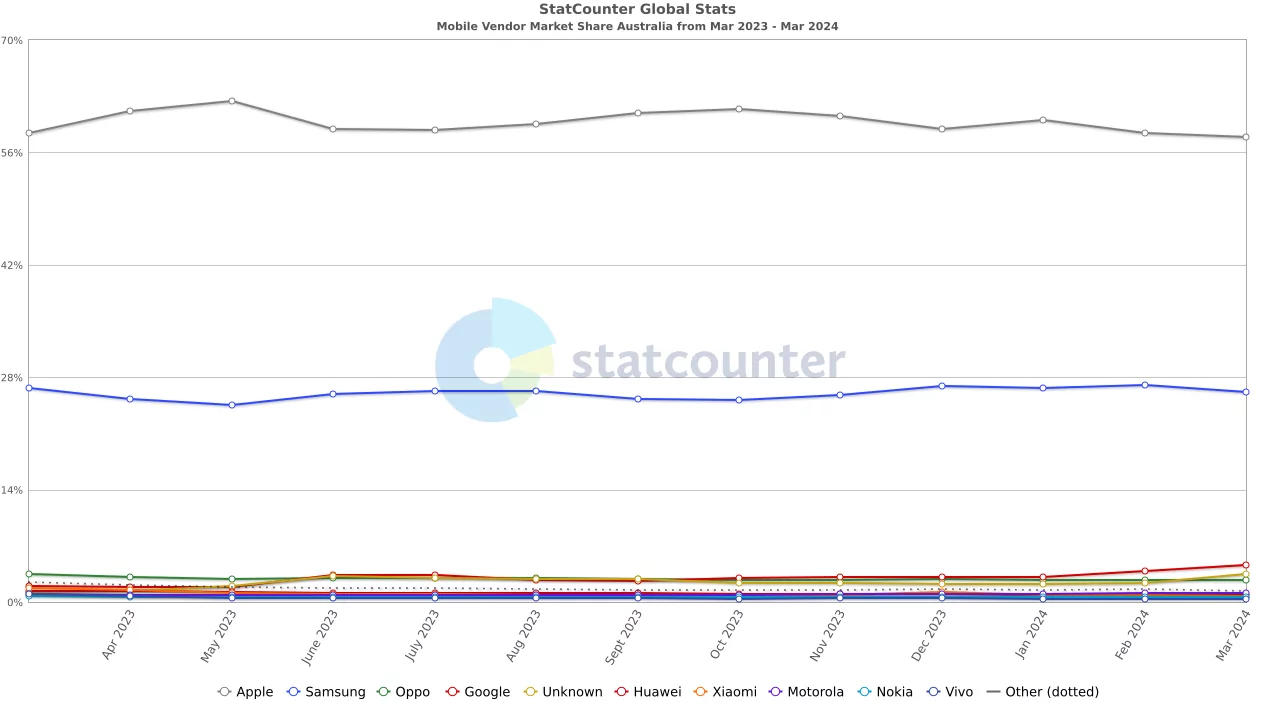
- Red Search
- Resources
- Australian Mobile Phone Statistics
Australian Mobile Phone Statistics 2024
-
 Daniel Law
Daniel Law
Mobile phones and devices are a wide range of handheld computers or smartphones that let you perform various tasks, including text messaging and audio calling. But mobile devices have existed for so long to offer just that.
Until this year, modern mobile phones have become ubiquitous due to their wide range of uses, from communication to entertainment, education, and business.
In 2024, technological advances such as 5G and AI are being integrated into mobile devices, pushing the limits of handheld technology and further enhancing their integration into people’s lives.
As businesses demand faster paces and more interconnectivity, having a mobile phone that is constantly reachable is critical to everyday business operations.
Furthermore, smartphones have become lighter and more portable than ever, furthering their accessibility and ease of use. Smartphones now have better interconnection systems, allowing users to access the internet through Wi-Fi and mobile broadband.
The Internet and mobile devices have been instrumental in helping businesses grow and scale online. As a Sydney SEO agency, we craft growth strategies designed to take advantage of the mobile phenomenon, serving many industries in Australia.
Latest Mobile Devices Statistics in Australia 2024
Australia is a developed country at the forefront of advancing technologies, including mobile phones, eSIMs, and devices. Since mobile phones were introduced in the country, Australians have employed them for myriad purposes.
How many people use phones in Australia?
Numbers from Statista show that mobile phone users and penetration levels in Australia are constantly rising. From 19.9 million users in 2017, the number of Australian smartphone users is expected to increase by 3.7 million to 23.6 million by 2026.
These statistics show a rapid rise in mobile phone users, which will certainly evolve the digital landscape in Australia. Smartphone usage is rising, and so is consumers’ appetite to engage with online products and services.
How many Australians don’t have a smartphone?
The latest Digital 2024: Australia report by Meltwater and We Are Social revealed that only 3% of Australian internet users aged 16-64 don’t have smartphones. Putting into perspective, that’s barely 756,300 people.
What is The Most Used Phone in Australia?
Looking at both Apple, smartphone (Android) and feature phone markets, here are the highly sought-after phones in Australia we’ve handpicked from PCMag:
- Apple iPhone 15: The most popular iPhone for the general public
- Google Pixel 8: The most popular Android smartphone for most people
- Apple iPhone 15 Pro Max: Go-to choice for the most powerful iPhone
- Samsung Galaxy S23 Ultra: Best high-end Android phone
- Samsung Galaxy A14 5G: Best budget smartphone
- Samsung Galaxy Z Fold 5: Best foldable phone
From the list, it’s easy to spot that two brands consistently pop up. Which brand, out of Apple and Samsung, is more popular in the Australian market?
Is Apple or Samsung more popular in Australia?
Apple remains the leading smartphone brand in Australia at 58.42% market share, a 31.42% gap from Samsung’s 27% market share. With 234.6 million sold worldwide, the iPhone dethroned Samsung in 2023, outpacing the South Korean company’s 226.6 million.
Consequently, the smartphone penetration rate in the country is also bound to increase. Given the nationwide shutdown of the 2G network and the introduction of 5G, the 2023 penetration level of 86.3% will grow to roughly 86.6% in the coming year.
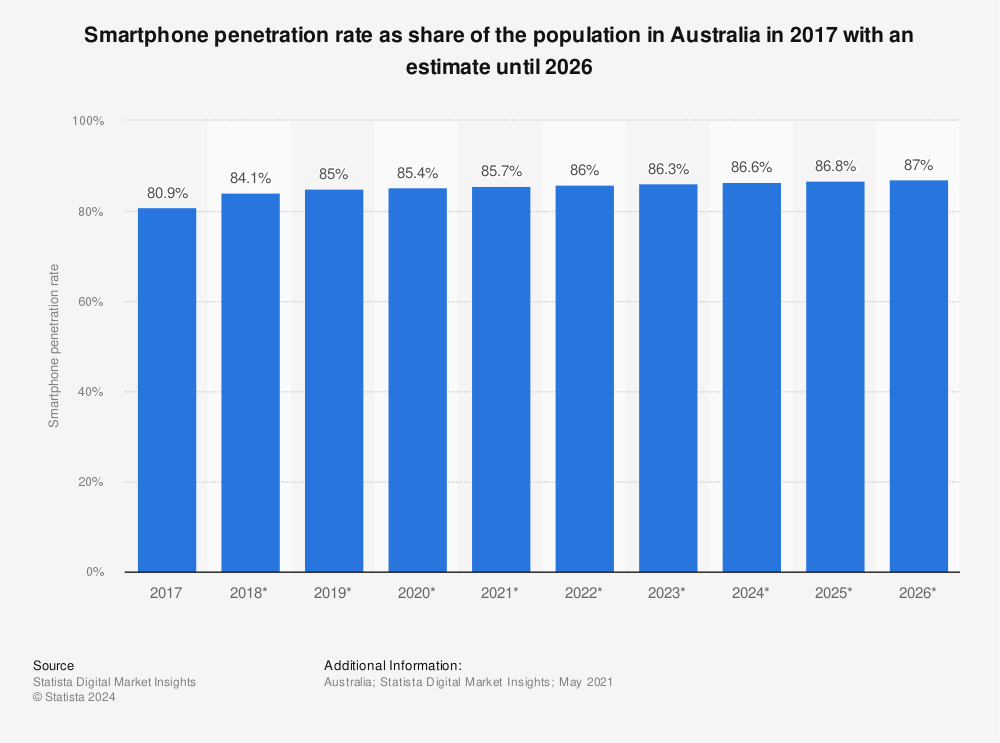
5G, The Internet, and Mobile Devices in Australia
In the previous year, smart mobile devices were truly one of the greatest technological inventions the world has witnessed. With internet connectivity, users can reap the full benefits of a mobile device.
Smartphone users can conveniently access the internet over Wi-Fi or mobile broadband to go online whenever and wherever.
5G Network Geographical Distribution Across Australia
The three Australian Mobile Network Operators (Telstra, Optus, Vodafone) have deployed around 4,000 5G network sites nationwide, with more added at the latest.
The 5G network facilities distribution shows NSW tops the 6 states with 1,218 5G network site developments. Other states report as follows:
- Victoria (VIC): 917 site developments
- Queensland (QLD): 835 site developments
- South Australia (SA): 444 site developments
- Western Australia (WA): 271 site developments
- Tasmania (TAS): 138 site developments
- Northern Territory (NT): 0 site developments
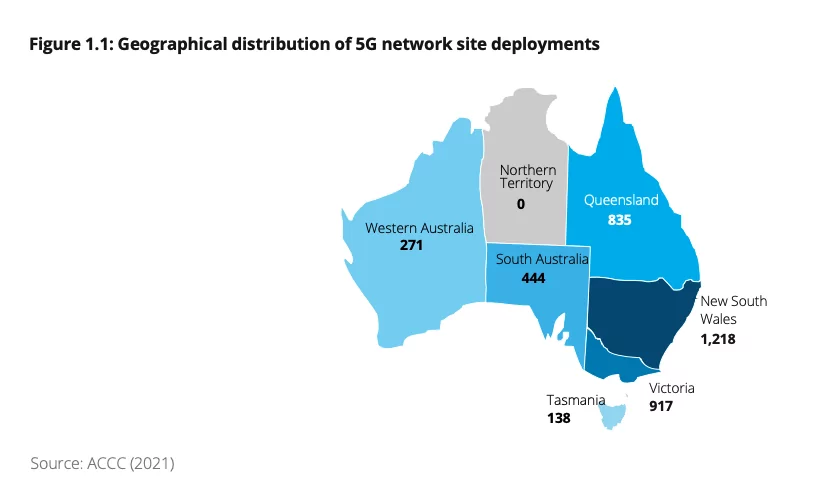
Source: Deloitte Mobile Nation
Australia’s Dividends for Expanding 5G Networks
Adopting new technologies in businesses and industries is an intense race within and beyond Australia. Businesses are now seeing the potential of 5G applications and are expanding the use of 5G networks.
The latest Deloitte statistics reveal that forecasts predict increased dividends using 5G applications as it improves business readiness and integrates more businesses in the network.
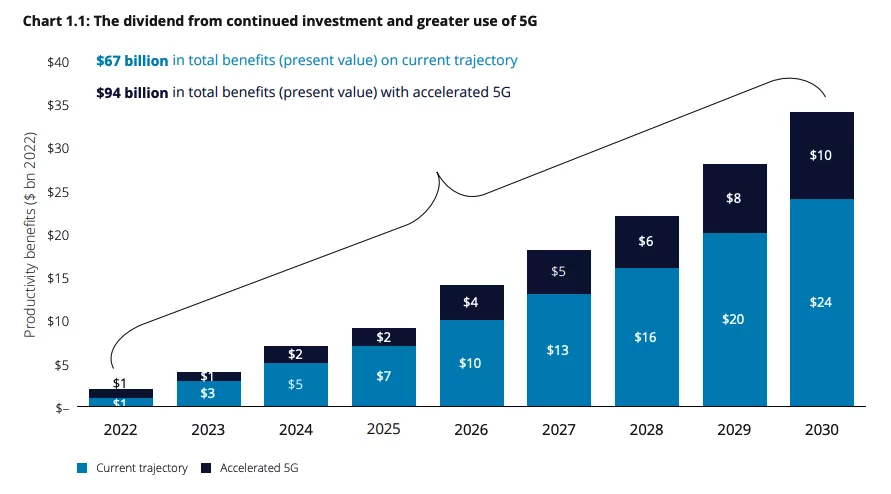
5G and Australia’s Telecom Industry
5G is the latest global wireless standard designed to connect everyone, including smart devices, appliances, objects, and even cars. It offers astonishingly low latency and a more massive network capacity capable of transferring 10 Gbps.
According to the latest Mobile Network Experience Report in Australia, Optus has emerged as the mobile network with the fastest 5G download speed, with records clocking at 226.5 Mbps, 12.2% faster than Telstra and 2.2 times (220%) faster than Vodafone.
- Optus: 226.5 Mbps
- Telstra: 201.9 Mbps
- Vodafone: 102.5 Mbps

Moreover, Optus’s 5G Network Coverage Map indicates that the network provider has connectivity across capital cities and surrounding suburbs. Optus has begun rolling out 5G since 2019, with current figures estimating about 1000 sites distribute 5G 900Mhz frequency bands nationwide.
The latest Opensignal Mobile Experience Awards hailed Optus as the winner, leading both the overall 5G experience 5G Video Experience, and a Joint Winner status with Vodafone for service & experience consistency.
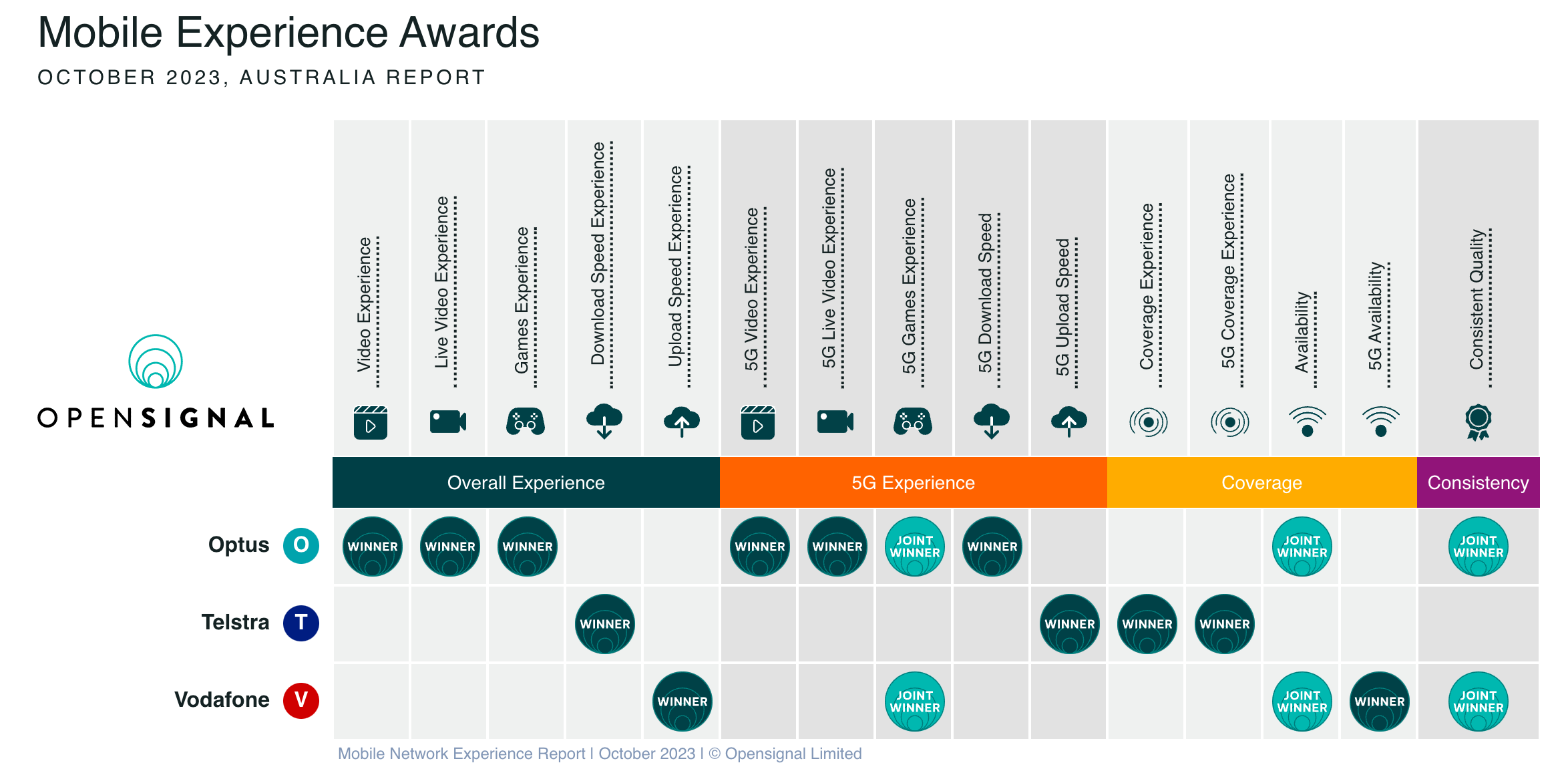
Internet and Mobile Device Users in Australia
Due to the availability of 5G and smartphones in Australia, accessing the internet at any time and place has become much easier. In addition, the country is also one of the developed countries with the fastest mobile internet speed.
Thus, it is unsurprising that internet surfers in Australia usually spend an average of 6.8 hours a day browsing online using various devices. However, around 55% of Australian web surfers prefer using mobile devices over laptops or desktops to go online.
The percentage of Australian smartphone users who say they connect to the internet over 5 times a day (53%) and over 15 times a day (20%) supports this data.
How Australians are Using Their Mobile Phones in 2024
Australians use their smart mobile devices to accomplish myriads of tasks conveniently. A great proportion of Australians use smartphones for social media and messaging apps.
A Deloitte survey shows that approximately 90% of Australians possess a mobile device. On average, people use smartphones for three hours daily to play, work, and interact with friends and family.
Other uses of smartphones include taking photos, digital payments and money transfers, checking news and weather, tracking health and fitness, and gaming. Mobile phones used for entertainment, such as watching live TV (45%) and streaming movies and TV series (23%), continuously increased.
Furthermore, about 6 in 10 Australian households use mobile devices instead of three other items, such as phone books, road directories, cameras, calculators, calendars, and alarm clocks.
Undeniably, mobile phones are an all-in-one device, making them a daily necessity. Around 94% of Australian smartphone users say they stay on their devices when leaving their houses. They take their phones more than they do their wallets and house keys.
How Australian Children Are Using Their Mobile Phones
Since 2015, Australia has seen a 5% increase (41% to 46%) in children aged 6 to 13 using a mobile phone.
- 54% of children have neither owned nor have access to a mobile device
- 33% of children own a mobile device that they use
- 14% of children have access to a mobile device but don’t own it
Most Australian kids use their mobile phones to play games, take photos or videos, and use phone apps. All usage statistics show that the number of children engaging with or using their smartphones is rising.
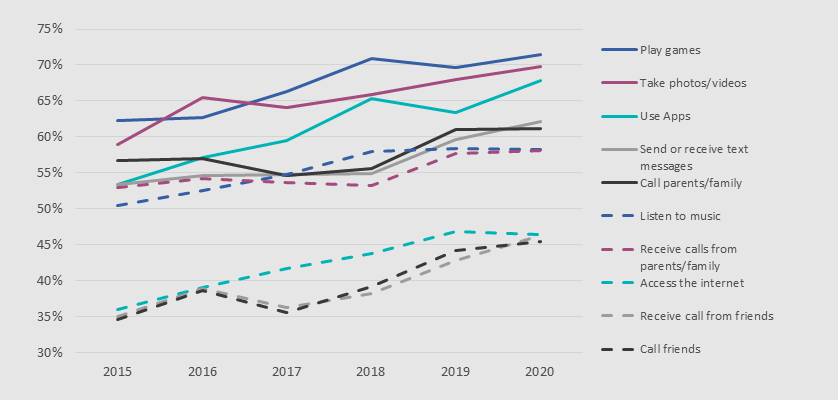 Source: ACMA
Source: ACMA
Positive Effects of Mobile Phone Technology
The same Deloitte survey shows that two-thirds of Australians consider mobile phones helpful in their daily endeavours, and roughly half (48%) say they provide freedom.
Additionally, more than 70% say smartphones give them peace of mind and security since they can be used in an emergency.
Here are some positive effects mobile phone technology offers.
- Social Connection – Whether through text messages, audio calls, video calls, or chat, smart devices allow for better and easier global communication.
- Convenience – With just a few taps on the screen, you can accomplish various tasks that you have had to do physically. This includes paying bills, hailing taxis, booking appointments, and even working and studying anytime.
- Physical Health Monitoring – Around 18% of the Australian population has adopted wearable mobile devices to monitor their health and track their fitness journey.
- Stay Updated – Mobile phones let you stay updated with current happenings and trends.
Negative Effects of Mobile Phone Technology
Not everyone agrees that mobile phone technology has only brought about positive effects. 1 in 10 Australians find mobile phones annoying, while 4 in 10 find them distracting.
Additionally, 32% of smartphone users in Australia expressed that the use of mobile devices increases their stress and anxiety. Below are the downsides of mobile phone technology.
- Over-reliance on mobile phones – This is especially true for young people. One survey by Vodafone revealed that 45% of their customers say they cannot live without a mobile phone.
- Safety risks – Security breaches are a real threat to Australian smartphone users, and around 87% fear this from happening. Likewise, about 82% are concerned about their phones distracting them while driving.
The Impact of Mobile Devices on eCommerce
The merging of the internet and mobile phones has proven a powerful tool in businesses, especially in eCommerce. Smartphones have drastically transformed the way business owners conduct business online.
As the 10th largest eCommerce market by revenue worldwide, Australia tremendously benefits from mobile phone technology. In 2019, with 81% of the population shopping online, the number of online shoppers in the country is already at 20.3 million.
This is expected to grow in 2021; the Australian eCommerce market is forecast to be at $35.2 billion. By that year, the number of online buyers will reach 22 million and the eCommerce market penetration level will be 85.2%.
Shopping and Searching for Services
Smart mobile devices opened up countless opportunities for shoppers to look for the products and services they need and the brands they want.
Online mobile shoppers can even filter the search results according to their preferences, such as the location or service area, product colour and size, and more.
Online Purchasing and Booking
Mobile shopping allows for faster transactions through checkouts, digital payments and online booking. This eliminates the need to visit physical stores and pay over the counter for the goods you want.
Brand Awareness and Customer Engagement
Small and medium businesses (SMBs) that employ digital strategies (such as leveraging SEO services, Google Ads or Facebook Advertising) have better chances of gaining leads and being known to their target market than brands with physical outlets only.
Given Australia’s relatively high smartphone penetration level, companies can harness the full potential of presenting their brand online and making their website mobile-friendly. Besides, half of SMBs in Australia already employ mobile-friendly websites to drive leads.
Brand Loyalty
By providing a seamless and valuable mobile user experience, companies can build the trust of their customers and potential clients so that they will keep coming back. This would only be possible if they developed their site to be mobile-responsive, reliable, and functional all throughout.
We expect better network infrastructures and faster mobile data speed in the coming years. With the introduction of 5G, more and more business opportunities are available in stores.
Furthermore, it is forecast that there will be a steady increase in companies adopting digital technologies, so we can only look forward to a future where mobile devices play a major role in business and eCommerce.
If you want to read more industry insights and love fresh data, check out our other statistics posts:
Global Mobile Phone Statistics FAQs
1. How many mobile phone users are there globally in 2024?
In 2024, there were roughly 4.5 billion mobile phone users globally, a 13.8% increase from the previous year’s 3.94 billion users.
2. What is the current smartphone penetration rate?
It is estimated that Australia will reach an 86.6% penetration rate in 2024, representing just over 23 million users across the country. This is strongly reflected by the ongoing growth in smartphone adoption with 2G network shutdowns and the uprising of 5G networks.
3. What is the global market share of major smartphone operating systems?
Android dominates the smartphone market with 72% of the market share. iOS holds roughly 27% of the market, placing it second. Other smartphone OSs, such as HarmonyOS and KaiOS, account for the remaining 1%, with very niche growth in certain regions like India, Brazil, and Indonesia.
4. How many smartphones were sold worldwide in 2024?
The global smartphone market saw a 5.8% increase in sales after recording 1.23 billion units sold in 2024.
5. Which manufacturers lead the global smartphone market in 2025?
Apple is currently the world’s biggest smartphone manufacturer, with a 28.38% market share globally.
6. How much time do users spend on mobile internet daily?
Australian internet users aged 16 to 64 spend about 2 hours and 56 minutes using the internet on mobile phones daily. Moreover, 94.1% of these users access the internet via mobile phones.
7. How many app downloads occurred globally in 2024?
In 2024, there were around 230 billion app downloads globally, with around 14 billion downloads in the first half. Communication and productivity apps account for the majority of these app downloads.
8. What is the total revenue generated by mobile apps in 2024~2025?
Mobile app revenue surpassed $200 billion in 2024 and is approaching 2025, with most of the profit coming from in-app purchases and app subscriptions.
9. How has augmented reality (AR) been integrated into mobile phones?
From novelty purposes like AR games, augmented reality can now be used for several purposes, including:
- Product comparison: Scanning a variety of eCommerce products via AR for a more personalised experience
- Gaming: Interact with the real world using AR to gamify real-world locations and maps
- Interactive messages: Users can now use AR filters to send customised messages that receivers can interact with, allowing for a richer experience.
10. How much e-waste is generated from mobile phones annually?
The latest reports estimate that we generate roughly 62 million tonnes of eWaste annually, rising to 82 million tonnes by 2030.
11. Which regions dominate the smartphone market in 2025?
The APAC region is expected to dominate the smartphone market in the coming year, with a record 89 million sales volume in Q2 2024, up 14% from last year. The Greater China region comes close with about 75 million units sold in the same quarter.
12. What is the average smartphone upgrade cycle in 2025?
By 2025, the average smartphone upgrade cycle is estimated to be around 2.5 years as more people consider upgrading to newer models that better meet their increasing needs for improved storage, better cameras, and more capabilities.
13. What are the projected revenues for the mobile phone market by 2025?
The global mobile phone market is expected to reach roughly $800 billion in revenue as several regions and local markets experience continuous growth.
14. What are the key innovation drivers in the mobile phone industry for the future?
By far, the biggest innovation drivers pushing the mobile phone industry to new heights include the seamless integration of AI and virtual reality into daily use, which provides a personalised experience for each smartphone user..
Connectivity is also a key innovation driver that accommodates our ever-increasing data consumption. That includes further research and development on 6G connectivity.
Written by


